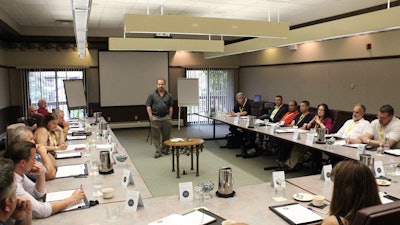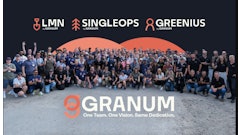
What are some of the biggest challenges facing the snow and ice removal industry today? What will the industry look like 10 years, even 20 years, from now? These were two questions addressed recently by snow and ice professionals and other industry members at a retreat near Buffalo, NY. The three-day event, referred to as “Through the Looking Glass,” was arranged and facilitated by Snowfighters Institute president John Allin.
“The industry has come a long way over the last 15 to 20 years,” Allin told the group. “Two decades ago, there were no national and regional snow companies and very few companies of any size generated the bulk of their revenue from pushing snow. For most landscape contractors, pushing snow was something they did because their customers and clients demanded it.
“Technology has changed dramatically, too. Imagine not being able to pick up your smartphone and text, check the weather (there were no weather services designed to accommodate snow contractors anyway), or stay in touch with virtually every person in the field. Google Earth and global mapping of properties were not even on the horizon.”
Back in the 1990s, there were no snow melters, Allin pointed out. Liquids were hardly ever used, nearly every contractor worked by the hour, and litigation was not the big elephant in the room that it is today.
With change come challenges
Over the course of the three-day retreat, participants were asked to identify challenges and pose scenarios of how meeting them would impact the industry’s future. To name but a few, they cited an upsurge in litigation and liability that has driven up insurance costs, eroding customer loyalty, and a zero tolerance for ice that has doubled salt use.
Among others, they identified one issue that hasn’t changed and one that needs to. The one that hasn’t changed is an industry driven by snow events, a challenge that continues to put contractors on call 24/7. One that needs to change is profit margin, which has been steadily decreasing.
Participants estimated that the mean gross profit for most commercial snow contractors is around 45%, with a net of somewhere between 10 and 20%. Making an adequate profit, they emphasized, is a requisite for buying new equipment, staying up with technology, and having a cash reserve to deal with unexpected storms like the one that buried the East Coast this past winter.
Throughout the retreat, one theme permeated the discussions: education. Education is a key component for anyone or any company to successfully adapt to change. It’s an ongoing learning process, the group emphasized; one that applies equally to contractors and to their customers.
Going forward requires going back … to school
“This is a huge industry comprised of those who remove snow for industrial, commercial and government facilities in addition to smaller companies that work in the residential market,” Allin reminded attendees. “At one extreme, the average size contractor in the industry generates around $150,000 for plowing snow for HOAs and residences. At the other, 10 of the largest national companies, prominent as they are, do only 4% of the snow removal in this country, primarily for large retail customers.”
The group agreed that members of both industry segments and many of those in between can improve their business models and operating efficiencies. They can also learn how to communicate more effectively with customers to share challenges and make life easier and more profitable for all parties involved.
Here, they projected a bigger role for national and state associations. Offering courses or workshops that would guide property managers on how to select the right snow contractor was one suggestion. Another was to survey property manager pain points, something that would be valuable for delivering optimum service to them.
Associations could also gather and disseminate statistics for larger retailers, data that would make them aware of how much they are spending on litigation vs. hiring a true snow and ice management professional. One Looking Glass participant pointed out that Walmart reportedly spent $93 million on litigation last year vs. $75 million on snow removal. Spending more on the latter would substantially reduce the former.
“We need to get the message out that less services equate to more risk," said one veteran snow contractor,” admitting, however, that it’s a balancing act for large retailers. “They have to manage their risk while at the same time meet shareholder expectations. For the snow and ice management company salesperson, it may simply come down to how successfully he or she can actually sell risk.”
The industry could also be well served by being proactive, the group concluded. For example, encouraging building architects to include island-less parking lots and heated sidewalks into their specs would facilitate snow and ice removal and reduce maintenance costs. The downside? Snow contractors with the right equipment already have a competitive advantage managing difficult sites.
Pervasive theme
The important role that education will play in the coming decades doesn’t end with helping contractors improve operating efficiencies or helping customers reduce their risks. It extends to virtually every corner of the industry, from weather conditions and understanding how to take advantage of future advancements in forecasting to litigation and how better tracking and documentation of site presence can reduce liability.
Successful snow and ice professionals will embrace new technologies and take advantage of future satellite and GPS advancements that will automatically adjust a blade or a salt spreader to conditions, thus reducing reliance on experienced and trained operators. Technology, again, will allow the creation of virtual offices that can reduce “back end” administrative cost by 75 to 80%.
An effective marketing campaign similar to the dairy industry’s “got milk” could help raise awareness about the value snow and ice professionals bring to the table. The group also emphasized that the industry needs to enhance its working relationship with service providers who will continue to play a key role.
Throughout, Allin encouraged Looking Glass participants to be creative and to think outside the box. One participant predicted that buyer co-ops similar to those already in vogue in agriculture would help ensure a timely, affordable supply of salt.
Another suggested that partnering with insurance companies to set standards would help the industry police itself. Another still looked for smaller companies to form strategic alliances to help one another during weather extremes.
This is a just a quick peek at a few of the topics addressed during several brainstorming sessions, all designed to help paint a picture of the snow industry’s future. The challenges the group spelled out were real—how the industry meets them will determine just how accurate the painting is.
In the coming months, The Snowfighters Institute plans to publish a book on the group’s findings. It will be available to industry members and others who will benefit from peering “Through the Looking Glass.”


![Doosan Bobcat Wacker Neuson Stack 2ec Js Pb V6e[1]](https://img.greenindustrypros.com/mindful/acbm/workspaces/default/uploads/2025/12/doosan-bobcat-wacker-neuson-stack2ecjspbv6e1.CPyyz8ubHn.png?auto=format%2Ccompress&bg=fff&fill-color=fff&fit=fill&h=100&q=70&w=100)








![Doosan Bobcat Wacker Neuson Stack 2ec Js Pb V6e[1]](https://img.greenindustrypros.com/mindful/acbm/workspaces/default/uploads/2025/12/doosan-bobcat-wacker-neuson-stack2ecjspbv6e1.CPyyz8ubHn.png?ar=16%3A9&auto=format%2Ccompress&bg=fff&fill-color=fff&fit=fill&h=135&q=70&w=240)








